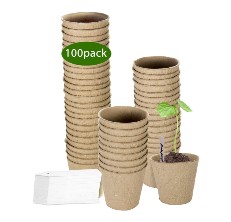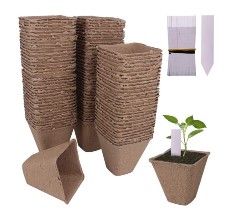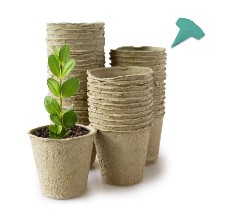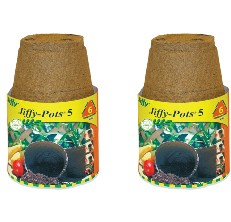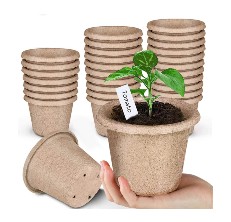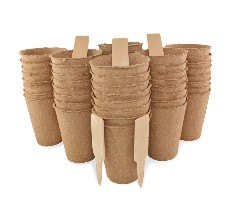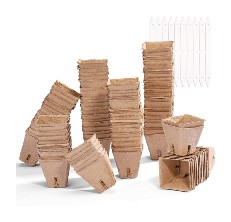- Flowers & PlantsVegetablesOur content is meticulously curated through independent research, testing, reviews, and AI-driven recommendations, all designed to present you with the finest product choices. When you make a purchase through our links, it could result in us earning a commission.
The Best Peat Pots of 2024
Last updated: Apr 24, 2024
Collection of peat pots for seedlings isolated on a white background. Concept of spring planting, house plants, garden tools, growing seedlings.
Have you ever tried to transplant small seedlings from one pot to another? It’s no easy feat! The process of moving plants from one source of soil to another can yield many negative effects, like transplant shock and root damage. But with peat pots, you can avoid the prospect of stressing out your plants. This is because you’ll get to place the seeds into the ground along with the pot instead of taking the seeds out of the soil and placing them somewhere new. This entire process reduces the risk of root injury, and the biodegradable pot can break down in the soil. That way, your plants can mature without any root obstruction. To take a peek at the peat pot we like the most, check out the ZOUTOG Three-Inch Peat Pots.
Our Top Picks For Peat Pots
- Best Overall: ZOUTOG Three-Inch Peat Pots Shop Now ➔
- Runner Up: Huvai Biodegradable Peat Pots Shop Now ➔
- Honorable Mention: GROWNEER Peat Pots Shop Now ➔
- Contender: Plantation Round Peat Pots Shop Now ➔
- Also Consider: ANGTUO Peat Pots Shop Now ➔
- Most Convenient to Use: Daniel's Peat Pots Shop Now ➔
- Also Great Option: Delxo Seed Starter Peat Pots Shop Now ➔
View all ContentsThe Best Peat Pots
Best Overall
Zoutog round peat pots are three inches tall and three inches in diameter, making them the perfect size for vegetable seedlings, starting flowers, and other seeds. Seeds can be cultured indoors and outdoors in these little pots which are especially kind to plants that don’t like having their roots disturbed, such as melons and cucumbers.
This peat pot order comes in a pack of 100 pots and 100 white plant labels. The plastic labels can be marked with a pencil or marker and cleaned for reuse with a household cleaner. Once your seedlings start to grow there is no need to remove them from the peat pots when replanting them in the ground. This prevents transplant shock and root damage, making these peat pots our #1 choice.
Pros
- Three inches in height
- Three inches in diameter
- Sturdy enough to start seedlings
Cons
- Doesn’t wick water like most peat pots
Runner Up
These square peat pots measure 3.15 inches in diameter and height with a tapered base of 1.57 inches. The square pots come in an order of 100 pieces with an additional 100 white plastic plant markers for labeling your little plants.
The pots are made from natural plant fibers and are environment-friendly and biodegradable. The peat pots absorb and retain water well and are perfect for transplanting your herbs, seedlings, or flowers without causing root circulation or harm since they are degradable and compostable, breaking down naturally in the soil over time. Since the peat pot can be placed directly into the ground, they are ideal to use for tender rooted vegetable seedlings, transplanting, or cuttings. These pots are also available in a bigger round size and a 3×4 cavity tray.
Pros
- Holds up well in gardens
- Maintains its shape over time
- Long-lasting and durable
Cons
- Does not have drainage holes
Honorable Mention
These cylindrical peat pots are available in 30, 60, or 120 packs. The pots are 4 inches in diameter and also come with plant labels so you can keep track of your seedlings. These peat pots make starting an indoor garden easy. The pots don’t have any holes in the bottom and are 100% biodegradable. Once your seeds sprout, simply transplant the whole pot into the ground or into a larger pot.
As the plant grows, the roots can still penetrate the peat which also breaks down in the ground over time to completely submerge your plant into the surrounding soil. These organic peat seedling pots are made from organic paper peat and are perfect for herbs, vegetable saplings like tomatoes, and starting flowers.
Pros
- Gives plants sufficient room to grow
- Peels easily when it’s time to replant
- Eco-friendly design and materials
Cons
- Can develop mold very easily
Contender
Plantations’ round peat pots are slightly bigger than the usual seedling pots, measuring 5 inches in diameter. They are also available in a 6-inch size. The package comes in two packs of 6, for a total of 12 round pots, offering you plenty of space to grow seedlings.
These biodegradable peat pots are made from Canadian sphagnum peat moss and stand solidly on their base due to their big size. This prevents them from tipping over. The extra width also provides more space for root growth before they are planted in the ground, which is especially useful during seasons when it is still too cold to grow temperature-sensitive herbs and vegetables outdoors. When the weather warms up, simply place the whole pot in the ground and let it continue to grow naturally in the soil.
Pros
- Very sturdy design
- Easy to plant
- Excellent price for 12 pots
Cons
- Can break under sufficient pressure
Also Consider
Angtuo 100% natural peat pots are 4 inches in diameter and 3.2 inches deep. These great eco-friendly pots are breathable, absorbent, and biodegradable, making them perfect as seedling starter pots, as well as for growing flowers, herbs, strawberries, vegetables, and hanging plants.
Also available in square shapes, these pots eventually merge with the root ball and promote aeration for healthy plant growth. This makes them ideal for transplanting your flower or herb seedlings without causing root damage or transplant shock. The package includes 30 pots and 20 plastic plant labels. Angtuo prides itself on great customer service and is happy to engage with customers regarding any product queries.
Pros
- Durable and safe design
- Allows for oxygen exchange
- Great size at a great price
Cons
- Mold might build up inside
Most Convenient to Use
Unlike other peat pots that come with non-degradable plastic plant labels, Daniel’s Plants has gone the extra mile to ensure that even the plant markers are environment-friendly. The pack of 60 round, 3-inch diameter peat pots comes with 10 wooden plant labels, completing the organic look of your herb garden and remaining completely nature-friendly.
These unique pots are made from nothing but peat moss and spruce fibers. They are sustainably produced, 100% natural, organic and are suitable for aquaponics, hydroponics, and traditional growing methods. Being fully biodegradable, these organic seedling pots are perfect for starting herbs, flowers, and vegetable saplings. Since they merge with the root ball and promote aeration, they are ideal for transplanting plants without harming the roots. Daniel’s Plants is proudly OMRI certified and operates on a 100% customer satisfaction guarantee policy.
Pros
- Very sturdy design
- Perfect amount of thickness
- Great size for plants
Cons
- Doesn’t break down as fast as others
Also Great Option
Delxo’s small seed starter peat pots measure 2.1 inches square and 2.2 inches deep. They have drainage holes in the bottom and the pack of 102 small pots includes 20 plastic plant labels. The seed starter trays are made from paper and peat moss. They are eco-friendly, completely recycled, and easily degradable.
These little peat pots are permeable to water and air, overcoming problems like rotten and crooked roots in seedling cultivation common with plastic pots. The pots will gradually soften once placed in the soil, meaning you don’t have to dig the seedlings out of the plant pots manually. Instead, just place the entire casing inside the ground. This places less stress on your seedlings, improving their chances of survival.
Pros
- Strong and reliable
- Very thick construction
- Plants can be removed easily
Cons
- Don’t soak up water very well
The Best Peat Pots: Buying Guide
Whether you already have green fingers or are just learning the ropes to creating your herb or flower garden, peat pots are a fantastic way to get going with your planting season. These eco-friendly pots have loads of benefits and will help you build a successful indoor or outdoor garden in no time. In this guide, we’ll help you choose the best peat pots and explore how they can enrich your garden.
What Are Peat Pots?
These biodegradable pots are made of peat that is compressed and formed into the shape of a plant pot. Like any other pot, you will need to add potting soil. The real advantage of using these pots comes at planting time when the entire peat pot can be placed in the soil. Since it is entirely composed of natural materials, it eventually loses its form and becomes part of the soil around the plant. These pots are eco-friendly and biodegradable, so you also don’t have to worry about any plastic going into landfills.
Peat is partially decayed plant material that forms in wet conditions such as marshes and swamps. As plants die and fall to the ground, they begin to decompose. Due to high water content and lack of oxygen in the swamp of decaying plant material, decomposition slows down. New layers continue to form on top as more plants, leaves, and vegetation gather. Peat is harvested from these bogs for various uses.
As an agricultural product, peat can retain soil moisture and help improve soil structure. Although it doesn’t offer any nutrients to the soil, it can hold nutrients, which means as a short-term growing medium, it will provide seeds with consistent moisture and nutrient retention. Once planted in the soil, the pots also help to keep moisture around the roots of the plant until they decay.
How Are Peat Pots Made?
Commercially, manufacturers of peat pots take large quantities of the peat material and saturate it in water, causing it to turn into a thick sludgy mixture. Wood pulp is added for rigidity. The mixture is blended to form a peat slurry which is then pressed into the intended pot shape. This squeezes out the excess liquid and also compacts the moss and wood pulp. Once dried thoroughly, the pot is ready. Although the wood pulp keeps the pots rigid, they will eventually start to lose their shape, so keeping your plants in these pots is not a long-term option.
Advantages of Using Peat Pots
Peat pots are thicker and larger than peat strips, which allows you to grow your seeds or seedlings until they reach a fair size. This gives you more time to ensure your seedlings are growing healthily before planting them in the soil, especially when weather conditions are not yet ideal for outdoor growing.
Once your plants are ready for the outdoors, you can simply place the entire pot and plant in the soil. This reduces root shock, root damage, and places less stress on the plant. Since peat is a partially decomposed material already, the pots will continue to decompose in the soil after planting, and the roots will expand.
There are disadvantages to using peat pots, but do they outweigh the advantages? Find out in this short video below.
Things To Consider When Choosing Peat Pots
The type of peat pot you choose will largely depend on what you are planting. Square and round pots work equally well, although square pots can be a little more stable if you have many stacked next to each other.
The size of the pot should be able to handle your new plant’s growth until it is ready to go into the garden. Small pots and trays are perfect for seed germination and seedlings, however, if you want a fair amount of growth for flowers or vegetables, opt for a bigger pot that will allow some root growth to happen inside the pots. Thicker pots will provide support for longer but will also take more time to decompose in the soil.
Choose a pot that can be entirely submerged in the soil when the time for planting comes around. Any part of the peat pot that is exposed to the air above the soil will dry out. This will cause the soil around it to dry out faster and deprive plants of water. You can tear or cut off the top part of the pot before planting to solve this issue.
When purchasing peat pots make sure they are 100% biodegradable. You will also want to use a good, high-nitrogen fertilizer or potting mix since the peat requires nitrogen to decompose and does not offer any additional nutrition to the plant or soil. Liquid fertilizer can also do the trick.
People Also Asked
How do you germinate seeds using peat pots?
To germinate seeds with peat pots, fill the trays with your desired potting mix. Sow your seeds directly into the planting mix, and then place them in a warm place to germinate. The warmth of the peat helps the seeds germinate quickly. Do not over-water the trays, but make sure you keep the peat and soil damp.
Can plant roots grow through peat pot walls?
Yes, plant roots can grow through peat pot walls. Peat pots are porous, meaning they let air and water circulate while allowing plant roots to grow through them. If you are concerned about this when replanting, saturate the pots in water. Then, loosen the base by making shallow cuts around the sides and through the bottom of the pot. Alternatively, you can remove the entire base of the pot.
Why are my peat pots moldy?
If mold forms in the peat pot, this may indicate excessive moisture. To avoid problems that can occur from overwatering, allow the potting soil to dry between waterings, and make sure your pots get enough sunlight.
Article Contributors
Read More About Garden Gate Review Team HereThe Garden Gate Review Team is a group of writers, editors, and gardeners, dedicated towards writing trustworthy product reviews that'll help you choose the best products for a beautiful garden and backyard.
Garden Gate is reader-supported: When you buy through links on our site, we may earn an affiliate commission. Artificial Intelligence (large language models) may have been used in the research and creation of the content.
Please reach out to aimperiapt@gmail.com with any questions regarding product testing or specific articles.

